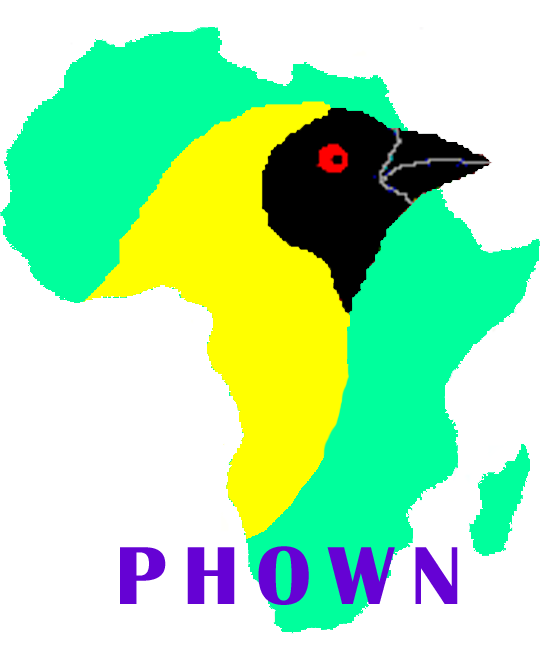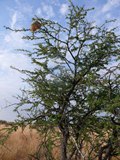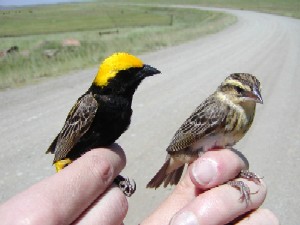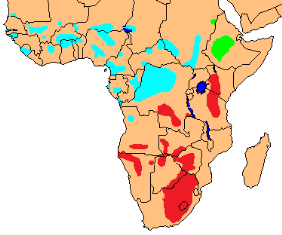Weaver species
Choose different species from drop-down list and press 'Go' button. See Full species list.Yellow-crowned Bishop Euplectes afer
IUCN: Least concern Discovery: 018Categories: wetland, pest, black and yellow bishops,
News items about species
Discovery
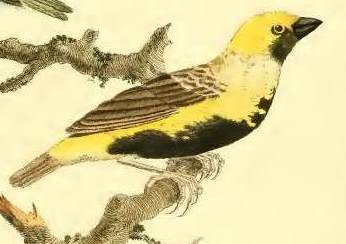
figure from Brown 1776 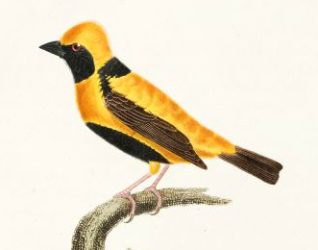
figure from Vieillot 1805 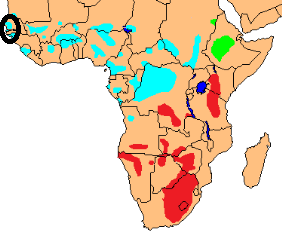
distribution, type locality circled IntroductionThe Yellow-crowned Bishop was formally named by Johann Friedrich Gmelin, a German naturalist. Gmelin described many new bird species in a book in 1789 in the style of Linnaeus' publications, giving a brief description in Latin and a synonomy, including a reference to Peter Brown, an English naturalist and illustrator. Gmelin noted the locality for the Yellow-crowned Bishop as Africa.Peter Brown was the first to write about, and illustrate, the Yellow-crowned Bishop. He called it the Black-bellied Grosbeak and gave a description of the bird. Brown notes that his specimen was in the collection of Thomas Pennant,an English ornithologist. Pennant travelled in Europe but not in Africa, so he would have obtained it from someone else. The bishop would have been brought by ship from Africa to England, where it would have been purchased by Pennant [note: in the species text, Brown misspelled Pennant as Tennant, but acknowledged Thomas Pennant in the Preface]. The type locality was later restricted to Senegal, based on Vieillot 1805 who listed specimens from Senegal and Ethiopia. The Ethiopian specimens are based on a different subspecies of the Yellow-crowned Bishop, and thus cannot be a type locality. Buffon 1778 had noted that James Bruce, a Scottish traveller, mentioned and painted the Yellow-crowned Bishop in Ethiopia. Scientific citationLoxia afra Gmelin 1789 Syst. Nat., 1(2), p.857 Africa (Senegal; Grant & Praed, 1944, BBOC, 65, p.10).Meaning of namesafer (Latin): African, from Africa.First English nameBlack-bellied Grosbeak (Brown 1776).Alternate namesGolden Bishop, Napoleon Bishop, Taha Bishop.CollectorUnknown.Date collectedBefore 1776.Locality collectedAfrica = Senegal.Type specimensType specimen not located; the illustration of Brown 1776 serves as a type. |
The above is based on Weaver Wednesday 2, a weekly series about the discovery of each weaver species.
This species text first appeared as
Weaver Wednesday [135] - Discovery [18]: Yellow-crowned Bishop on 2015-01-14
1. Basic biology
The above is based on Weaver Wednesday, a weekly series about weaver species.
This species text first appeared as
Weaver Wednesday [3]: Yellow-crowned Bishop on 2012-07-04
2. Breeding facts
| Pair bond Polygynous Breeding season mainly Jul-Oct from W Africa E to W Sudan and in NE DRCongo, Oct in Ethiopia, Jan-Apr in S DRCongo and Angola; records in Jan-Jun in Kenya and Tanzania; in S Africa mainly Dec-Mar, some records as late as May in areas with erratic rainfall Nest site attached usually less than 1 m above ground or water to vertical stalks, hidden in tuft of grass or in bushes, rushes and sedges, often in flooded or waterlogged area Nest building built by male Colony size in small colonies Clutch size 2-4 eggs, average 3 (South Africa) Egg colour white with fine dark spots, often concentrated at thick end Egg size average size of 88 eggs 17.9 x 12.8 mm (South Africa) Incubation in captivity, incubation by female only, period 12-14 days Chicks and nestling period male assisted with feeding of young, nestling period c. 13 days |
Breeding information based on Handbook of the Birds of the World, Vol. 15.
3. Photos of Weaver Nests
 Vm 29790 |  Vm 24919 |  Vm 19069 |  Vm 15781 |  Vm 22 |
Thumb-nails of most recent PHOWN records - click on one to see its full record
See all PHOWN records for this species here.
PHOWN (Photos of Weaver Nests) provides valuable info on breeding distribution and colony sizes of weavers.
You can contribute by registering and submitting photos at Virtual Museum webpage.
4. Breeding distribution
Google map showing distribution (For species with small ranges you need to zoom in at the correct area to see the range):
yellow blob - range of weaver species; read more about this here.
![]() - PHOWN records with photos
- PHOWN records with photos
![]() - PHOWN records with no photos (Nest Record Cards, other records)
- PHOWN records with no photos (Nest Record Cards, other records)
![]() - Birdpix records
- Birdpix records
![]() - comments on out of range records, or interesting records
- comments on out of range records, or interesting records
![]() - type locality
- type locality
CLICK on the marker on the map to see individual record details.
5. Range changes
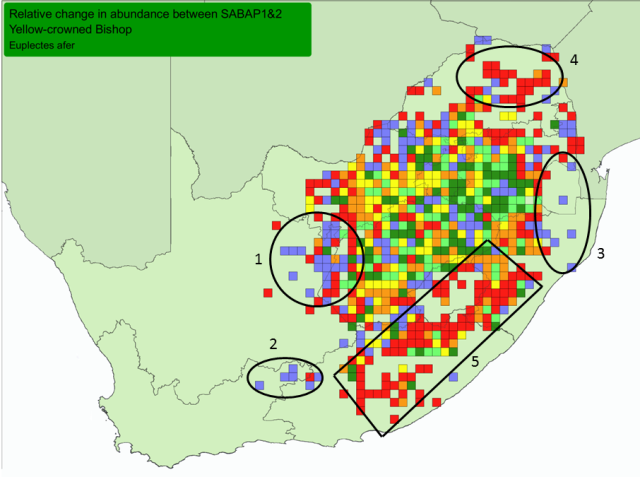
Red, orange and yellow = cells with very large, large, and small relative decreases Blue, dark green and light green = cells with very large, large and small relative increases. Cells = quarter-degree grid cells; Only cells with at least 4 checklists in both SABAP1&2 shown. All cells had this species recorded in SABAP1 or in SABAP2 or in both (more about interpretation at Biodiversity Observations 7.62: 1-13).
Range changes in SA
The points below match the points on the map above. Areas with very large increases include:
Areas with very large decreases include:
The greatest changes appear on the edges of its range. This is not too surprising as this species is somewhat nomadic, depending on ephemeral wetlands. Range changes elsewhereZimbabwe: movements in relation to dry conditions (Baker 2012b).Exotic populations established in foreign countries, especially Spain and Portugal, also Hawaii, Jamaica, Japan, Puerto Rico: Appendix of Dyer EE, Redding DW, Blackburn TM. 2017. The global avian invasions atlas, a database of alien bird distributions worldwide. Nature Scientific Data 4 no: 170041. | |||||||||||||||||||||||||||||||||||
The above is based on Weaver Wednesday 3, a weekly series about range changes in South African weaver species.
This species text first appeared as
Weaver Wednesday 3 [257] - Range changes [20]: Yellow-crowned Bishop on 2017-05-17







